![]()
![]()
![]()
Use LEFT and RIGHT arrow keys to navigate between flashcards;
Use UP and DOWN arrow keys to flip the card;
H to show hint;
A reads text to speech;
65 Cards in this Set
- Front
- Back
|
What are eicosanoids?
|
The signaling molecules synthesized from 20-carbon polyunsaturated fatty acids (PUFAs, eicosanoic acids)
|
|
|
What are the members of the eicosanoid family?
|
1. Prostaglandins
2. Prostacyclins 3. Thromboxanes 4. Leukotrienes |
|
|
What are the precursors of the eisonanoids?
|
1. Dihomogammalinolenic acid
2. Arachidonic acid 3. Eicosapentaenoic acid |
|
|
What catalyzes the first step in forming eicosanoids?
|
Phospholipase A2 (PLA2)
|
|
|
What is released as a biproduct of the reaction catalyzed by phospholipase A2 (PLA2)?
|
Fatty acids esterified to the sn2 position of the membrane phospholipid.
|
|
|
What generates fatty acids for eicosanoid synthesis?
|
Non-pancreatic secretory PLA2s
|
|
|
What is the regulated enzyme in eicosanoid synthesis?
|
cytosolic phospholipase A2
|
|
|
What does cytosolic PLA2 release as a biproduct?
|
arachidonic acid (AA) from membrane phospholipids
|
|
|
What physiologic stimuli activates cytosolic PLA2?
|
1. adrenalin (epinephrine)
2. Bardykinin, ANG II 3. Vasopressin (aldosterone) 4. certain Ag-Ab complexes |
|
|
What non-physiologic stimuli activates cytosolic PLA2?
|
1. mechanical tissue damage
2. ischemia 3. venoms 4. Tumor promoters such as the phorbol esters |
|
|
What are the products of membrane phospholipid catabolism by PLA2?
|
Lysophosphatidate and Arachidonate
|
|
|
What do the eicosanoid cascades ("arachidonate cascades") begin w/?
|
Eicosanoic acid
|
|
|
What does the cyclic or cycloxygenase pathway synthesize in the eicosanoid cascade?
|
1. prostaglandins
2. prostacyclins 3. thromboxanes |
|
|
What does the linear/lipoxygenase pathway synthesize?
|
1. leukotrienes
2. hydroxyeicosanoates |
|
|
What catalyzes the first step in the lipoxygenation pathway?
|
5-lipoxygenase
|
|
|
What catalyzes the first step in the cyclooxygenation pathway?
|
Prostaglandin endoperoxide H synthase (PGHS)
aka "cyclooxygenase or COX" |
|
|
What are the products of the cycloxygenase pathway chemically related to?
|
Prostanoic acid
|
|
|
What are the catalytic activities of PGHS/COX?
|
two catalytic activities:
1. Arachidonic acid -> prostaglandin G2 *catalyzed by cyclooxygenase w/ O2* 2. Prostaglandin G2 -> Prostaglandin H2 *catalyzed by peroxidase w/ glutathione* |
|
|
What are the three beginning eicosanoic acids?
|
1. GLA (dihomogammalinolenic acid)
2. Arachidonic acid (AA) 3. Eicosapentaenoic acid (EPA) |
|
|
What does GLA preferentially become? what catalyzes the rxn?
|
Becomes prostaglandin F1-alpha, catalyzed by PGH1
|
|
|
What does AA preferentially become? what catalyzes the rxn?
|
prostaglanding F2-alpha, catalyzed by PGH2
|
|
|
What does EPA preferentially become? what catalyzes the rxn?
|
Prostaglanding F3-alpha, catalyzed by PGH3
|
|
|
What does the lipoxygenase br of the eicosanoid casacde lead to?
|
1. HPETE (hydroperoxyeicosatetraenoic acid)
2. HETE (hydroxyeicosatetraenoic acid) 3. leukotrienes |
|
|
What are the members of the leukotriene family?
|
1. LTB4 - a dihydroxyacid
2. LTC4, LDT4 & LTE4 - the cysteinyl-leukotrienes |
|
|
What is the function of the leukotrienes?
|
mediators of the allergic response and of inflammation.
|
|
|
What is the action of eicosanoids?
|
They are regulatory molecules:
1. Autocrine - action in or on the cells that synthesize them 2. Paracrine - action on nearby cells |
|
|
What affect do eicosanoids have on platelets?
|
They activate platelets and participate in plug formation
|
|
|
What do platelets bind to at the site of endothelial injury?
|
Collagen
|
|
|
What does binding of platelets expose?
|
Thrombin receptors (proteinase activated receptors, PAR)
|
|
|
How does thrombin activate platelets?
|
Receptor-bound thrombin activates platelets by cleaving a short polypeptide from the receptor extracellular segment.
|
|
|
What happens to platelets when they are activated?
|
1. they change their shape
2. release a battery of substances 3. become sticky (goopy!) 4. form a platelet plug. (*splork*) |
|
|
What follows PAR1 activation?
|
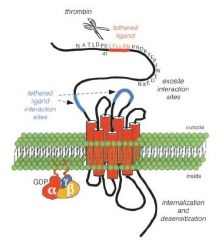
A rapid burst of signaling before the resceptor is desensitized/cleared from the surface. (BOOM!)
|
|
|
How is PAR-1 activated, chemically?
|
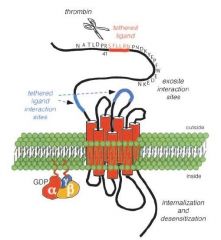
PAR-1 is cleaved by thrombin on a strand that hangs outside of the membrane. Thrombin cleaves PAR1 b/e arginine 41 and serine 42 to expose a new N-terminus that serves as a tethered ligand.
|
|
|
What substances do activated platelets secrete that activate additional platelets?
|
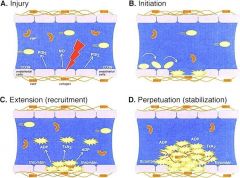
1. ADP
2. Thromboxane A2 (TXA2) |
|
|
What do activated platelets release?
|
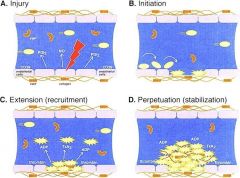
1. factors that activate other platelets
2. clotting factors leading to thrombus (clot) formation |
|
|
What inhibits platelet aggregation?
|
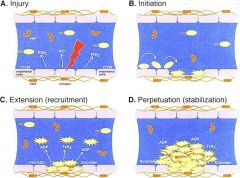
Prostacyclin I2 (PGI2) which is secreted by endothelial cells.
|
|
|
What helps modulate the rate of thrombus formation?
|
The opposing actions of TXA2 and PGI2
|
|
|
What does aspirin (acetylsalicylate) do in the blood?
|
Inhibits the cyclooxygenase (COX) activity of prostaglandin synthase, this accounts for the antithrombotic activity of aspirin.
|
|
|
Why do populations that consume fish oil rich in N-3 highly unsaturated fatty acids (omega 3 HUFAs) have fewer strokes and heart attacks?
|
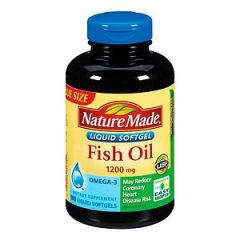
1. EPA is converted to PGH more slowly than arachidonate
2. TXA3 is produced when EPA is the starting substrate 3. TXA3 is less effective than TXA2 as a platelet activator 4. This slows the formation of the platelet plug. |
|
|
What is the difference b/e arachinoic acid (AA) and eicosapentaenoic acid (EPA)?
|
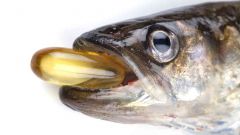
AA has a faster conversion to TXA2, TXA2 is more effective at activating platelets than TXA3.
EPA has a slower conversion to TXA3, which is less effective at activating platelets that TXA2. |
|
|
What are the classical markers of inflammation? and what causes them?
|
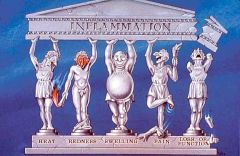
1. Rubor: Redness. Due to vasodilation w/ inc. Q
2. Calor: heat: due to inc. vasodilation w/ inc. Q 3. Tumor: swelling. Due to edema, a consequence of increased vascular permeability 4. Dolor: Pain. Due to stimulation of nerve endings by chemical mediators of inflammation. |
|
|
What drug inhibits PLA2?
|
Adrenal corticosteroids such as cortisol
|
|
|
What drug inhibits 5-lipoxygenase?
|
Zyflo
|
|
|
What drug inhibits prostaglanding synthase?
|
Ibuprofen
|
|
|
What drugs decrease the production of all products of the eicosanoid pathways?
|
Adrenal corticosteroids (cortisol and prednisone)
|
|
|
What drugs inhibit the COX portion of PGH2 synthase?
|
NSAIDS like ibuprofen (Flurbiprofen which is a competitive inhibitor of COX)
|
|
|
What is the difference b/e COX1 and COX2?
|
They are isoenzymes, COX1 is constitutively expressed and COX2 is induced by inflammatory stimuli and cytokines
|
|
|
What inhibits both COX1 and COX2 isoenzymes?
|
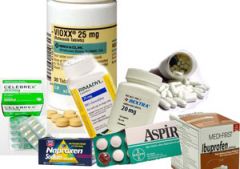
NSAIDS (ibuprofen, motrin, advil and nuprin)
|
|
|
What drugs selectively inhibit COX2?
|
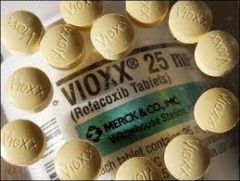
Celecoxib celebrex and refecoxib Vioxx
|
|
|
What inhibits both COX1 and COX2 by inhibiting synthesis of prostaglandins and related substances when arachidonate and peroxides are low but not when they are present at substantial levels?
|
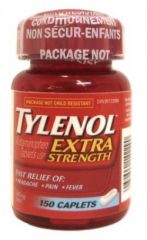
Acetaminophen (Tylenol)
|
|
|
What drug destroys the cyclooxygnation activity of both COX1 and COX2 by covalently inhibiting COX?
|

Aspirin (acetylsalicylate)
|
|
|
What does acetylated COX2 do?
|
It is still an active enzyme and is able to convert arachidonate to 15-R-hydroxyeicosatetraenoic acid (15 RHETE)
|
|
|
What is 15-RHETE? what does it do?
|
An aspirin triggered lipoxin (ATL); ATL and other trihydroxlipoxins promote resolution of inflammation
|
|
|
What drug promotes resolution of inflammation by stimulating production of 15-RHETE?
|
Aspirin
|
|
|
What does Zileuton (Zyflo) do?
|
Inhibits 5-lipoxygenase, the first enzyme in the pathway leading to leukotrienes.
|
|
|
What causes bronchospasm as a side-effect in the eicosanoid cascade?
|
Leukotriene
|
|
|
What dz is Zileuton used to treat?
|
Asthma/bronchospasm as a consequence of leukotriene activation.
|
|
|
What does Monteleucast (Singulair) do?
|
Blocks cysteinyl-leukotriene receptors, used to treat asthma.
|
|
|
What are the cysteinyl leukotrienes?
|
LTC4, LTD4
|
|
|
What is the function of the cysteinyl leukotrienes, LTC4 and LTD4?
|
Cause vasoconstriction, bronchospasm and inc. vascular permeability.
|
|
|
What eicosanoids have antiinflammatory properties?
|
Arachidonic acid
|
|
|
How does arachidonic acid act as a antiinflammatory?
|
AA is converted to 15lipoxygenase and glutathione peroxidase which are converted to 15S-HETE.
|
|
|
What converts AA to 15-R HETE?
|
Aspirin acetylated COX2
|
|
|
What are 15-R HETEs?
|
Substances that travel to leukocytes where they are hydrolyzed to 15-LXA4 and 15-epiLXA4
|
|
|
What antiinflammatory mediators are derived from AA and omega-3 polyunsaturated fatty acids?
|
Resolvins
|

